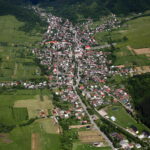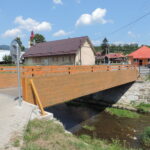Papradno, Slovakia
The municipality Papradno with its 2440 residents is located some 200km northwest of the Slovakian capital Bratislava, near the Czech border at the foot of the Javorníky mountain range. The area spans 5596 hectares, more than 80 percent of which are covered in forests, meadows, pastures and heathers creating an attractive and biologically valuable mosaic landscape. Large parts of it are nature reserves.
Papradno is aware of this scenic quality, which is why nature and environment protection as well as environmental awareness are of great importance. Agriculture is practiced in close touch with nature and has discovered an important second branch in agrotourism. Sheep farming and the processing of agricultural products – such as sheep milk cheese, lamb meat, honey and jams – create value and improve tourist offerings. There is also an educational nature trail and numerous sports facilities for horseback riding, hiking, cycling, sledding and (cross-country) skiing.More economic potential can be found within the trade and service enterprises.
Climate protection is both a global and local challenge for Papradno. Growing water scarcity due to a decrease in snow and sever weathers have caused the municipality to carefully maintain its springs and wells, to collect rain water, to stop using drinking water for gardening and to expand the riverbed of the local river Papradnianka in addition to installing water retention systems.
Use of renewable resources and energy is promoted, which can be seen in the bio mass heating systems of communal buildings (town hall and cultural center) and in the use of solar energy to heat changing rooms. Other climate-friendly measures include the creation of communal gardens, public charging stations for electric cars and bikes, the transition to LED street lighting and the planned rooftop greening on the cultural center.
The rich cultural heritage of Papradno is maintained and lived with great dedication and love, which is essential for the identity of its residents and tourists alike. Particularly noteworthy is the local dialect, the unmistakable three-part chants, offen accompanied by trumps, ocarinas and fifes, as well as the distinctive embroidery used on garbs, table cloths and decorative elements. Another characteristic are around 80 shepherd houses is the mountain range Javorníky, formerly inhabited by people from spring to fall, and the local wooden houses. The wooden house in the municipal center is considered national cultural heritage and is slowly being transformed into a municipal museum.
The tradition-conscious municipality also this ahead and has gone to great lengths to improve technological and social infrastructures. The water line, wastewater disposal, sewage plant, waste separation as well as the excellent supply in regards to groceries, health, education, services and in the social sector attest to their success. Examples include three grocery stores, a health and social center with doctors and a pharmacy, and the accessible kindergarten and school complex. The latter promotes not only the curriculum, but also other skills and talents.
The elementary school and kindergarten as well as the town hall, the so-called amphitheater and the cultural center are all locate within the municipal center. The cultural center was created with great involvement from the community and includes a restaurant, bar, hair dresser, library, a communal space, practice space for cultural activities, a cinema and a multifunctional event hall that holds 350 people.
Key actors in the successful development of Papradnos are its considerate administration which facilitates the inclusion of residents and specifically supports local entrepreneurs and young families, as its dedicated population and numerous associations that offer a variety of activities, ensuring a lively cultural and social life.
Lastly, the municipality impresses with its great awareness of problems. Next to environmental and climate protection, demographic changes pose another great threat to the community, specifically the growing superannuation of the population. Development efforts are therefore seen as a continuous process that constantly requires new solutions. Cooperation with and advice from experts from various fields are considered an essential pillar on the way to the future.
Evaluated: 2020







